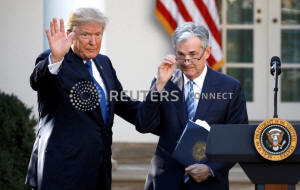Trump's economy 'a little under' 3 percent growth goal:
Fed
 Send a link to a friend
Send a link to a friend
 [February 23, 2019]
By Howard Schneider [February 23, 2019]
By Howard Schneider
WASHINGTON (Reuters) - The Trump
administration will fall "a little under" its target of 3 percent annual
growth of gross domestic product for 2018, the Federal Reserve said
Friday in a report that offers an economic scorecard of sorts for the
first full year of President Donald Trump's term.
The verdict: Mixed, and possibly going in the wrong direction. By year's
end, the impact of tax cuts and other policies was waning, trade was
detracting from growth and the federal deficit was wider.
On the upside, employment growth remained strong.
Though growth for the year was "solid," the Fed said, gross domestic
product "rose a little bit under 3 percent for the year as a whole," shy
of the pace White House officials have set as their touchstone for the
success of the president's policies.
Earlier this month White House economic adviser Larry Kudlow said growth
would prove to be 3 percent in 2018 and at least that much for 2019 - a
forecast the Fed also does not share.

The Fed said 2018 would prove "a noticeable pickup" from recent years,
but outlined an array of headwinds, including a drop in business and
consumer spending at year's end, that could carry over into 2019.
FILLING THE VOID
The Fed's estimate of last year's growth fills a void left by the recent
government shutdown, which delayed publication of the first estimates
for fourth-quarter and full-year 2018 growth by the Bureau of Economic
Analysis.
That official GDP figure is now due next week.
The Fed, however, in the meantime had to produce a full report to
Congress under a law requiring the central bank's chairman to appear on
Capitol Hill twice a year to update lawmakers.
[to top of second column] |

President Donald Trump gestures with Jerome Powell, his nominee to
become chairman of the U.S. Federal Reserve at the White House in
Washington, U.S., November 2, 2017. REUTERS/Carlos Barria/File Photo

That appearance is next week, and in an accompanying report, released in
advance, the Fed used its own sophisticated models to provide a bottom line for
2018.
Trump took office in January 2017, and by the end of that year had put a full
suite of economic policies into play, including a $1.5 trillion tax cut,
increased government spending, and an effort to reorder the global trading
system in the United States' favor.
White House officials said that would unleash spending and investment, fix the
U.S. trade deficit, and improve the government's balance sheet by yielding
enough extra revenue to offset the tax cut.
And some that was true at first, according to the Fed, though the impetus seems
to be weakening.
The strength of the labor market has been undeniable, with around 220,000 jobs
added monthly on average in the last half of the year, sidelined workers coming
back on the job, and falling unemployment rates "for all major demographic
groups."
But by year's end consumers were pulling back, and a bump in business investment
early in the year had "moderated," while corporate spending plans, business
confidence, and lower expected profits mean an even weaker investment climate
ahead.
International trade, after a "strong performance" that boosted GDP early in the
year, may end up as a net drag on the economy in 2018 after exports faltered
late in the year and "growth in real imports seems to have picked up" despite
the imposition of various tariffs.
As for the federal deficit, it widened to 3.75 percent of GDP in fiscal year
2018, which ended in October, compared to 3.4 percent the year before.
(Reporting by Howard Schneider; Editing by Andrea Ricci))
[© 2019 Thomson Reuters. All rights
reserved.] Copyright 2019 Reuters. All rights reserved. This material may not be published,
broadcast, rewritten or redistributed.
Thompson Reuters is solely responsible for this content. |